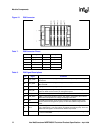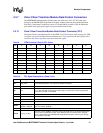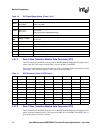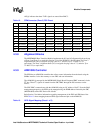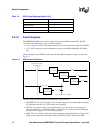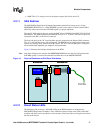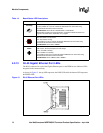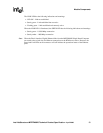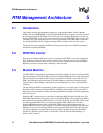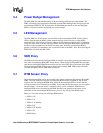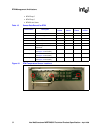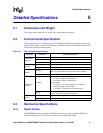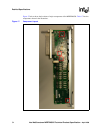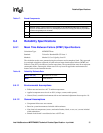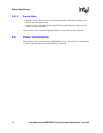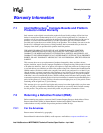
30 Intel NetStructure
®
MPRTM0020 Technical Product Specification – April 2006
RTM Management Architecture
RTM Management Architecture 5
5.1 Introduction
This section describes the management support for a non-intelligent Rear Transition Module
(RTM) such as the MPRTM0020. A non-intelligent RTM FRU does not have a controller on board
to communicate with the SBC IPMC. Instead, all of the non-intelligent RTM sensors and the non-
intelligent RTM FRU storage device are connected directly to the SBC IPMC. This is usually done
via dummy I
2
C sensor and storage devices. It is the responsibility of the SBC IPMC to make the
non-intelligent RTM look like a separate intelligent FRU controller to the rest of the system.
The feature that is not supported for RTMs is E-keying, since there are no PICMG requirements
defined for non-intelligent RTMs.
5.2 RTM FRU Control
Since the non-intelligent RTM does not have a payload, the SBC IPMC only needs to implement
the Cold Reset version of the FRU control command. This command does not cause the IPMC to
reset. Instead the command causes all of the sensor and state information for the non-intelligent
RTM to be set back to startup values, simulating a controller reset.
5.3 M-state Machine
The SBC IPMC is responsible for implementing the M-State machine for the non-intelligent RTM.
From the perspective of the Shelf Manager the non-intelligent RTM looks like a separate managed
FRU device with its own M-state that is separate from that of the IPMC. In order to do this, the
IPMC sends M-State transition messages to the Shelf Manager, accepts activation/deactivation
requests from the Shelf Manager, and negotiates power budgeting as if it were a separate RTM
controller.
The non-intelligent RTM is not intended to be hot-swapped in or out of the system. For this reason
the handle switch on the non-intelligent RTM is combined with the handle switch on the SBC. If
either handle switch is opened, both the non-intelligent RTM and the SBC will take the appropriate
action for removal.
When the SBC is inserted into the system the non-intelligent RTM is initialized to M0 state. The
SBC IPMC then checks for the presence of the non-intelligent RTM. If the non-intelligent RTM is
present then the non-intelligent RTM M-State is set to M1. In the M1 state the SDR records in the
non-intelligent RTM FRU device are incorporated with the IPMC SDR records. The non-
intelligent RTM then remains in M1 until the SBC IPMC reaches M4. At that point the non-
intelligent RTM transitions to M2 and waits for activation from the Shelf Manager. Once the Shelf
Manager activates the non-intelligent RTM, the non-intelligent RTM transitions to M3 and waits
for its power budget to be granted. Once the power budget is granted the non-intelligent RTM
transitions to M4 and stays there until a deactivation is received from the Shelf Manager or a
handle switch is opened.



